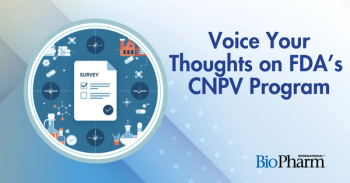
Innovation in Pre-packed Disposable Chromatography Columns
Research uncovers trends and factors affecting the pre-packed disposable chromatography columns market for downstream bioprocessing.
The market for pre-packed, disposable chromatography columns used for downstream bioprocessing is increasing rapidly. Requirements for greater productivity and efficiency and the move toward single-use and flexible facilities are fueling these changes. Future integration of single-use technologies into large-scale manufacturing is a primary driver.
There has been a clear spike in interest among biopharmaceutical manufacturers for pre-packed disposable chromatography columns. Back in 2010, BioPlan Associates’ Annual Report and Survey of Biopharmaceutical Manufacturing found that only 1% of the industry was interested in pre-packed column technology. Over the past few years that interest has grown to more than 27% of decision-makers who said they were at least considering adopting these new technologies (1). That rapid jump brings it near the level of interest given to other technologies that have been in the market for longer, such as buffer dilution systems/skids and continuous purification systems.
Much of this increase in interest has been due to acute bottleneck problems in downstream processing areas. Interest in alternative downstream technologies has spiked as a result. The level of consideration in pre-packed disposable columns has leveled off since then, but it remains significant. These “disposable” columns often appear to be used multiple times, and due to the current cost of resins being packed, few, if any pre-packed columns marketed today are in practice actually “single-use.”
Benefits of disposable pre-packed columns
The benefits afforded by pre-packed disposable columns can be broad reaching. They’re quicker to set up, and offer operational flexibility, with rapid changeovers. Proponents also point to how they eliminate the work involved in column cleaning, sterilization and packing; simplify validation and cleaning; allow for more runs, and reduce labor-hours, including column testing, validation and documentation. Other benefits include elimination (outsourcing) of non-core activities, and the benefits of receiving expert-packed, fully validated and documented columns, with smaller facilities potentially lacking needed specialized expertise and equipment.
In the future, complementary technologies such as continuous processing methods, specifically multi-column chromatography (e.g., using 4-6 columns in parallel instead of one large column), will also impact future growth for pre-packed disposable columns, as the need for consistency and efficiency moves the packing off-site. Some of these events are 5–10 years off, so the growth in sales and interest in these technologies is likely to continue.
Downsides of pre-packed columns
There are certainly cost and control advantages to facilities packing their own columns, rather than using pre-packed columns. Further, conventional chromatography columns are not as inherently limited in terms of sizes available. And while reusable columns do require a lot of cleaning validation, and parts replacement, those problems are less critical when facilities are producing multiple batches of the same product. Facilities that can get by with longer downtimes also won’t be as enthusiastic for the changeover speed advantages afforded by pre-packed disposable columns.
Market size for pre-packed disposable columns
The current size of the market for pre-packed disposable columns used in bioprocessing (typically greater than 1 L size) is approximately $45–$55 million. This estimate includes resins, materials, and services associated with pre-packed columns. We note that some manufacturers pack columns using their own resins, while others provide services-only using customer-provided materials, and others will pack columns with whatever resin is desired. This makes direct competitor comparisons difficult, especially given the high cost of some resins.
Disposable columns are reported to often be used multiple times, due to the current cost of resins being packed, so few if any pre-packed columns marketed today may be considered single-use. As the price of resins decreases, however, it is likely that these pre-packed columns will move into the single-use category, as well. In addition once larger, lower-cost single-use (or disposable) pre-packed columns are made available for large-scale clinical and commercial applications, this market is likely to increase rapidly.
Current market suppliers
The market for pre-packed disposable columns is currently dominated by GE Healthcare, which launched its Ready-to-Process columns four to five years ago. This has given GE a leading position spanning development- to commercial-scale. GE’s share of the chromatography resins market is substantial, and contributes to their dominance of the pre-packed market, with around 55%. This share may be greater if resin revenues at retail levels are included (e.g., GE’s largest Protein A columns may cost in excess of a quarter million dollars). Other companies, such as Repligen (~23% market share), Atoll Bio (~8% market share), ThermoFisherScientific/LifeTech, and EMD-Millipore, Biotoolomics, Bio-Rad, Qiagen, and others, each have less than 5%. GE’s size and brand recognition permits the company to package a broad array of applications. But other companies, such as Repligen, ThermoFisherScientific/LifeTech, and EMD-Millipore, have made inroads in niche areas of this market.
Pre-packed column suppliers that pack using their own resins include GE Healthcare and EMD-Millipore. Other suppliers pre-pack their columns using various manufacturers’ resins as a service, including Atoll Bio, Repligen, and other smaller service companies. In some cases, suppliers use their clients’ resins, and the high cost of these resins may not be included in market estimates (see Figure 1). Market suppliers include:
- GE Healthcare: ~55% global market share. GE Healthcare has been in the market for five years; they offer relatively comprehensive solutions (from process development through clinical manufacturing). GE discounts columns to market resins, and many consider GE to be a market trailblazer.
- Repligen: 20–25%, focusing on single-use or disposable manufacturing facilities. The company will pack clients’ resins, and offers nine different diameters and various heights.
- Atoll: ~8%, focused on Europe, the US, and Asia. Provides small-scale columns for process development (PD), as well as larger-scale columns for clinical manufacturing. Offers flexibility in sizes and will pack a variety of resins.
- Millipore: ~5%, relatively new to segment, but is growing, especially in non-Protein-A resins.
- Others: ~10% (including Life Technologies which recently launched a new Go-Pure line that includes packing resins from multiple suppliers, Biotoolomics, Bio-Rad, Qiagen, and other emerging providers, typically focusing on process development scale columns).
Market growth
The market for pre-packed columns is emerging as biomanufacturers recognize the benefits in consistency, and lower internal workload of having external specialists provide this service. As a result, a 10-15% growth is expected in 2014, and that growth rate is expected to ramp up to 20% annually by 2016. Fletcher Malcom, product manager for Repligen’s OPUS Pre-Packed columns notes regarding this relatively young segment, “The market could double in size in the next few years.”
The pre-packed column segment is leveraging suppliers’ innovative expertise in resins and services, as well as designs that meet users’ needs. Just a few examples:
External factors are also influencing growth, including the number of monoclonal antibodies (mAbs) in development and clinical trials, biosimilar developments, and facility expansions using single-use strategies. Speed-to-market and change over to next-candidate products are key decision factors favoring use of pre-packed columns. In the future, complementary technologies such as continuous processing methods will also impact future growth for pre-packed disposable columns.
Given the extent to which downstream purification has been a significant contributor over the past several years to capacity constraints (e.g., as upstream yields continue to advance) (1), one might expect that the market potential for these products—as a means to integrate the broad benefits of disposable applications, including speed, into larger-scale manufacturing--would be substantial.
This growth rate is also within the range expected by a number of industry observers, some of whom feel that pre-packed columns are the fastest growing chromatography market, around 12–15% annually over the next few years. A lot of activity with more players entering or consolidating is expected. In comparison, the overall resins market is expected to grow at around 7–8% annually over the next few years.
These estimates are based on a market that is currently limited to clinical trial materials, because pre-packed columns beyond the 30-cm diameter size are generally unavailable. As larger-scale columns (e.g., 45 cm-60 cm in diameter) are developed and become commercially feasible, the market potential could expand significantly. To date, 45-cm diameter columns are becoming a standard for many 500 L–1000 L bioreactor harvests. Larger pre-packed columns need to be developed that provide technical, economic, and logistical advantages. This R&D is being done by industry suppliers. According to Denise DeTommaso, director of US marketing at Atoll Bio, most suppliers, including Atoll are actively developing larger-scale platforms. DeTommaso notes, “Atoll manufactures MediaScout pre-packed columns that offer scalable formats to support process development through manufacturing applications.”
Buyers for pre-packed columns
A key early market for pre-packed disposable columns is CMOs involved with multi-product facilities that offer clinical materials. In addition to CMOs, they are also attractive to end-user companies fitting or building clinical trials facilities. For the time being, most pre-packed columns are not at the size where they can be widely adopted by larger, commercial-scale manufacturing (typically beyond 30 cm inside diameter [ID]). There are many applications for pre-packed disposable columns, and they each present different market opportunities. Also, keep in mind much the same columns are used throughout the chemical industry, so other related markets are also being served by pre-packed column vendors.
Buyers include process development facilities, where pre-packed columns allow convenience to evaluate many resins and formats, and pilot facilities, with fewer resources and time pressures that require different batches at difference sizes. For these facilities, packing of columns to follow GMP regulations is laborious and potentially risky.
In bioprocessing markets, specific applications may include:
Small-scale market--discovery and PAT applications: Disposable pre-packed columns can be used for process analytical technology (PAT) applications to clean up samples prior to analysis. But this application of disposable pre-packed columns might be considered a small market. Even assuming a 20% annual growth rate, biopharmaceutical manufactu-rers’ capacity is probably tapped fairly early. Given that adoption of PAT has a healthy future, however, this market could grow. Even so, this represents a small market for pre-packed columns. There may be a larger market for pre-packed columns in discovery and early R&D, for larger biopharma drug innovators. This may represent a significant growth segment.
Process development market applications: The size of markets for process development is largely a function of biologics in the development pipeline. A rough estimate for this market would include pre-packed column market size of $1–$5 million. Even with a projected annual growth rate of 10%, this remains a limited application for single-use pre-packed columns.
Large-scale bioprocessing market applications: The use of pre-packed columns in pre-commercial and process development scale bioprocessing is the bulk of the market today. Usage is moving into pilot and clinical/commercial-scale GMP manufacturing, where the market is likely to become more competitive. Essentially all biologics entering clinical trials have pilot and clinical batches manufactured using columns. As discussed, the market for OEM applications of pre-packed disposable columns could be growing rapidly when the technology for larger sizes advance and these devices reach commercial scale. However, this market is dependent on large-scale end-users, facilities that prefer to do most everything in-house, choosing not to pack their own columns.
The big question for large-scale commercial market penetration remains pricing, with the market likely not being persuaded to switch from in-house column packing without a significant cost motivation.
Conclusion
The need for better single-use and disposable systems in downstream processing is growing. BioPlan’s Annual Biomanufacturing Study has consistently indicated that the incremental improvements being applied to downstream chromatography steps are not resolving existing problems. Cost of Protein A resins, problems with packing columns, and the lack of cost-effective and large-scale disposable chromatography media and methods suggest that single-use technologies could alleviate many downstream issues. But so far, few cost-effective alternatives exist. The average $12,000-per-liter cost for Protein A and its recyclability makes it more difficult for disposable options to gain wide, large-scale market penetration.
The move toward disposable upstream bioprocessing and the implementation of more flexible facilities will continue to pushdownstream operations toward innovative alternatives. Some of these may include membrane adsorbers, and pre-packed, single-use chromatography columns. We expect the trend toward more vendors developing broader ranges of downstream technologies at higher quality and relatively lower cost will continue.
References
1. BioPlan Associates,
About the Author
Eric S. Langer is president and managing partner at BioPlan Associates, Inc., a biotechnology and life sciences marketing research and publishing firm established in Rockville, MD in 1989. elanger@bioplanassociates.com.
This article appears in the BioPharm International 2014 Single-use Systems eBook.
Newsletter
Stay at the forefront of biopharmaceutical innovation—subscribe to BioPharm International for expert insights on drug development, manufacturing, compliance, and more.




